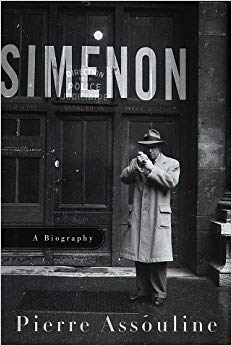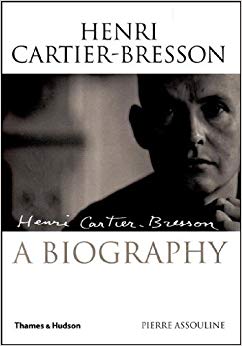Background
Pierre Assouline was born on April 17, 1953, in Casablanca, French Protectorate in Morocco (now Casablanca, Morocco).










(Traces the life of the influential French publisher and d...)
Traces the life of the influential French publisher and describes the development of the French publishing industry
http://www.amazon.com/gp/product/0151342938/?tag=2022091-20
1988

(One of the most beloved characters in all of comics, Tint...)
One of the most beloved characters in all of comics, Tintin won an enormous international following. Translated into dozens of languages, Tintin's adventures have sold millions of copies, and Steven Spielberg is presently adapting the stories for the big screen. Yet, despite Tintin's enduring popularity, Americans know almost nothing about his gifted creator, Georges Remi--better known as Hergé. Offering a captivating portrait of a man who revolutionized the art of comics, this is the first full biography of Hergé available for an English-speaking audience. Born in Brussels in 1907, Hergé began his career as a cub reporter, a profession he gave to his teenaged, world-traveling hero. But whereas Tintin was "fully formed, clear-headed, and positive," Assouline notes, his inventor was "complex, contradictory, inscrutable." For all his huge success--achieved with almost no formal training--Hergé would say unassumingly of his art, "I was just happy drawing little guys, that's all." Granted unprecedented access to thousands of the cartoonist's unpublished letters, Assouline gets behind the genial public mask to take full measure of Hergé's life and art and the fascinating ways in which the two intertwine. Neither sugarcoating nor sensationalizing his subject, he meticulously probes such controversial issues as Hergé's support for Belgian imperialism in the Congo and his alleged collaboration with the Nazis. He also analyzes the underpinnings of Tintin--how the conception of the character as an asexual adventurer reflected Hergé's appreciation for the Boy Scouts organization as well as his Catholic mentor's anti-Soviet ideology--and relates the comic strip to Hergé's own place within the Belgian middle class. A profound influence on a generation of artists such as Andy Warhol and Roy Lichtenstein, the elusive figure of Hergé comes to life in this illuminating biography--a deeply nuanced account that unveils the man and his career as never before.
http://www.amazon.com/gp/product/0195397592/?tag=2022091-20
1996

(An enthralling biography of a man whose life was the stuf...)
An enthralling biography of a man whose life was the stuff of fiction. Numbering more than 400 in all, including the beloved Inspector Maigret stories, Georges Simenon's novels have been translated into 50 languages, with sales exceeding 500 million worldwide. Now, drawing on unprecedented access to Simenon's papers, family and friends, Pierre Assouline gives readers the utterly absorbing story of this tormented and egomaniacal genius of literary mass production. 16-page photo insert.
http://www.amazon.com/gp/product/0679402853/?tag=2022091-20
1997

(Paul Durand-Ruel (1831-1922) is widely credited as the de...)
Paul Durand-Ruel (1831-1922) is widely credited as the dealer who "made" the professional careers of Renoir, Degas, Manet, Monet, Sisley, Pissarro, Puvis de Chavannes, and other painters of fin-de-siècle Paris. Driven by the conviction that the work of the Impressionists was an artistic revelation, he led the fight against critical opinion and brought these artists to the public. His event-filled life is the subject of this absorbing biography. Durand-Ruel risked his name, his fortune, and his family's future to become the outspoken champion of Impressionism, an art form that in France provoked only insults. By 1900 his gallery dominated the international market for Impressionism, and he had inspired a new generation of collectors, from merchant princes of Moscow to steel barons of Pittsburgh. This volume, deftly crafted from unpublished documents and letters, and illustrated with 40 black-and-white images, is an important addition to our understanding of Impressionism and collecting, as well as a dazzling tour of French and American art and cultural politics in the years before World War I. AUTHOR BIO: Pierre Assouline is one of France's leading historians and biographers. His many books include An Artful Life: A Biography of D. H. Kahnweiler.
http://www.amazon.com/gp/product/0865652414/?tag=2022091-20
2004

(The first full biography ever published on this complex, ...)
The first full biography ever published on this complex, curious, brilliant man. The twentieth century was the century of the image and Henri Cartier-Bresson (1908-2004) was the eye of the century. Through the decades, this eye focused on Africa in the 1920s, the tragic fate of the Spanish Republicans, and the victory of the Chinese Communists. It was Cartier-Bresson who fixed in our minds the features of his contemporaries: Giacometti and Sartre as characters from their own works; Mauriac mysteriously levitating; Faulkner, Matisse, Camus, and countless others captured at the decisive moment in portraits for eternity. An intensely private individual, Cartier-Bresson confided in his close friend Pierre Assouline over a number of years, even opening up his archives to him. Here, for the first time, we read about his youthful devotion to surrealism; his unending passion for drawing; the war and the prison camps; the friends and the women in his life. Assouline provides an acute and perceptive account of the life and philosophy of this icon of our times, and gives us an opportunity to reassess his contribution to twentieth-century photography and reportage. 23 illustrations.
http://www.amazon.com/gp/product/050051223X/?tag=2022091-20
2005
biographer historian journalist writer
Pierre Assouline was born on April 17, 1953, in Casablanca, French Protectorate in Morocco (now Casablanca, Morocco).
Assouline attended secondary school in Fidès and high school Janson-de-Sailly in Paris. He studied at the University of Nanterre and at the École des Langues Orientales.
Assouline first worked for agencies (Apei, Asa Press, Fotolib) before entering the foreign services of Le Quotidien de Paris, from 1976 till 1978, and France-Soir, from 1979 until 1983.
From the 1980s, he moved closer to the literary world, becoming a literary adviser to the Balland editions (1984-1986) and writing several books on recent cultural history, starting with a biography of Gaston Gallimard (1984). He joined the magazine Lire in 1985 and became an editor there in 1993.
He also worked on radio, at France Inter, for 4 years from 1986, and RTL, for 9 years from 1990. At France Culture, French public radio channel, he was a columnist at Le Monde 2, as well as a critic for Le Nouvel Observateur, and a member of the editorial board of the monthly L History.
Assouline is a lecturer of the first year's reading/writing course and the institute's school of journalism, at the Institute of Political Studies in Paris.
He joined the Academy Goncourt on January 11, 2012, serving there as a juror in the guise of Françoise Mallet-Joris.
His first book, De nos envoyés spéciaux: les coulisses du reportage, an examination of French foreign correspondents, was co-authored with Philippe Dampenon and published in 1977. In the early 1980s, Assouline wrote nonfiction works on such topics as the religious pilgrimage site at Lourdes and religious conversions before focusing on the biography genre in which he would later produce his best-known works. His first biography, Monsieur Dassault, which was published in 1983, examines the life and career of Marcel Dassault, a French aviation executive with Bordeaux-Aronautique. During the 1980s Assouline published additional biographies on such figures as the politician Jean Jardin and journalist Albert Londres.
Among Assouline’s works is the 1984 biography Gaston Gallimard: un demi-siecle d’édition française, which was translated into English by Harold J. Salemson as Gaston Gallimard: A Half-Century of French Publishing.
L'épuration des intellectuels, 1944-1945, published in 1985, offers Assouline’s examination of the postwar purge of French intellectuals who collaborated with the Nazis during the Occupation period of World War II.
Assouline’s 1988 work, L’homme de Tart: D.-H. Kahnweiler, 1884-1979, was translated into English by Charles Ruas as An Artful Life: A Biography of D. H. Kahnweiler, 1884-1979, in 1990.
In his 1992 biographical study, Simenon: biographie, which was translated into English by Jon Rothschild as Simenon: A Biography in 1997, Assouline surveyed the life and career of Georges Simenon, who was among the most flamboyant and prolific French authors of the twentieth century. Best-known for his series of “Inspector Maigret” detective novels, Simenon wrote hundreds of works under his own name and under more than fifteen pseudonyms, including twenty volumes of autobiographical material that disclose his numerous sexual exploits. This blog has been, for a few months, one of the most consulted of the French-language web news.
Assouline is the author of thousands of articles and radio columns.
His biography of Albert London earned him Prix de l'essai, awarded by the French Academy in 1989. His book La Cliente (1998) won the WIZO prize and the Liste Goncourt : le choix polonais. In 2005, the novel Lutetia (Gallimard editions) won the Maisons de la Presse award. This novel inspired director Frédéric Schoendoerffer for his film Lutetia. On October 10, 2007, Pierre Assouline won the Prix de la langue française. Job's Lives earned him the 2011 Mediterranean Prize and the 2011 Prince-Pierre-de-Monaco Prize.
(Paul Durand-Ruel (1831-1922) is widely credited as the de...)
2004(Traces the life of the influential French publisher and d...)
1988(One of the most beloved characters in all of comics, Tint...)
1996(The first full biography ever published on this complex, ...)
2005(An enthralling biography of a man whose life was the stuf...)
1997Assouline is a member of the "cultural committee" of the Artcurial, the Circle of Allied Union, and the club Le Siècle.
